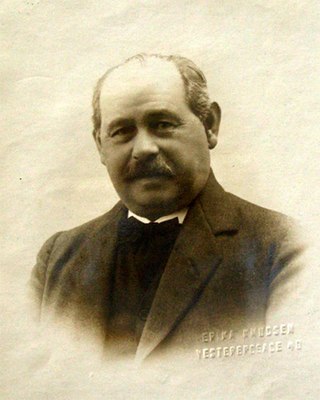
Horsens is a city on the east coast of the Jutland region of Denmark. It is the seat of the Horsens municipality. The city's population is 61,074 and the municipality's population is 94,443, making it the 8th largest city in Denmark.

Peter Vilhelm Carl Kyhn was a Danish landscape painter who belonged to the generation of national romantic painters immediately after the Danish Golden Age and before the Modern Breakthrough. Even though he outlived many of his artistic peers by several decades, he remained a traditionalist and expressed strong criticism of many of the new trends in the painting of his day.

Peter Christian Thamsen Skovgaard was a Danish national romantic landscape painter. He is one of the main figures associated with the Golden Age of Danish Painting. He is especially known for his large scale portrayals of the Danish landscape.

Johan Frederik (Frits) Nikolai Vermehren, also known as Frederik Vermehren, a genre and portrait painter in the realist style.

Peder Vilhelm Jensen-Klint was a Danish architect, designer, painter and architectural theorist, best known for designing Grundtvig's Church in Copenhagen, generally considered to be one of the most important Danish architectural works of the time. Its Expressionist style relies heavily on Scandinavian brick Gothic traditions.
Kristen "Kræsten" Iversen was a Danish artist who is remembered both for his paintings and his painted glass windows. He was a member of the Bornholm school of painters and a professor at the Royal Danish Academy of Fine Arts .

Anton Rosen was a Danish architect, furniture designer, decorative artist and professor at the Royal Danish Academy of Fine Arts. In his architecture, he combined a free Historicist style with inspiration from contemporary English architecture and details influenced by Jugendstil.

The Skagen Painters were a group of Scandinavian artists who gathered in the village of Skagen, the northernmost part of Denmark, from the late 1870s until the turn of the century. Skagen was a summer destination whose scenic nature, local milieu and social community attracted northern artists to paint en plein air, emulating the French Impressionists—though members of the Skagen colony were also influenced by Realist movements such as the Barbizon school. They broke away from the rather rigid traditions of the Royal Danish Academy of Fine Arts and the Royal Swedish Academy of Arts, espousing the latest trends that they had learned in Paris. Among the group were Anna and Michael Ancher, Peder Severin Krøyer, Holger Drachmann, Karl Madsen, Laurits Tuxen, Marie Krøyer, Carl Locher, Viggo Johansen and Thorvald Niss from Denmark, Oscar Björck and Johan Krouthén from Sweden, and Christian Krohg and Eilif Peterssen from Norway. The group gathered together regularly at the Brøndums Hotel.

Johannes Knud Ove Jais-Nielsen was a Danish painter, designer and ceramist, best known for the religious figure groups that he designed for the Royal Copenhagen pottery.

Harald Slott-Møller was a Danish painter and ceramist. Together with his wife, the painter Agnes Slott-Møller, he was a founding member of Den Frie Udstilling.
Albert Georg Kongsbak was a Danish artist. He was born on 20 February 1877 and died on 21 October 1958 He is most famous for his landscapes in the realist or naturalist style. He moved to Copenhagen when he was ten years old. He created drawings throughout his childhood. He trained as a painter and visual artist at the Royal Art Academy in Copenhagen from 1895 to 1901. At the Academy Kongsbak developed into a naturalist painter.

Vilhelmine "Ville" Jais Nielsen was a Danish painter and sculptor. She is remembered for the many portraits of women she painted while in Sweden during the Second World War, marked by strong brushstrokes and sensitive lighting effects. Her husband was the artist Jais Nielsen.

Rågeleje is a former fishing village and popular tourist resort on the north coast of Zealand, midway between Gilleleje and Tisvildeleje, some 50 km north of Copenhagen, Denmark. As of 2022, it had a population of 736.

Svend Hammershøi was a Danish painter and ceramist. He is remembered principally for the classical pottery designs he contributed to the Royal Copenhagen and to Kähler's Ceramics Factory in Næstved.

Frederik Hansen Sødring was a Danish landscape painter and founder of an endowment.

Anna Sophie Lorenze Petersen was a Danish painter. Although she showed some promise as an artist, specifically in genre painting, she struggled to find a place in the male-dominated Danish art world of the late 19th and early 20th centuries. Her work fell out of fashion and she was largely forgotten until the end of the 20th century when the Hirschsprung Collection and Statens Museum for Kunst acquired some of her more important works.

Suzette Catherine Holten was a Danish painter and ceramist who belonged to the Skovgaard family of artists. In addition to landscapes, flower paintings and portraits, she created and decorated ceramics and also worked as an embroiderer. As a woman, she was unable to achieve the same level of acclaim as her father or brothers.

Franz Šedivý was a Danish illustrator most known for his detailed bird's-eye view prospects. He worked for many of the leading newspapers and magazines of his time. His work was also featured on postcards, advertisements and in schoolbooks.

Philip Wulff Heyman was a Jewish Danish industrialist who co-founded the Tuborg Brewery. He was also a pioneer of Danish butter and bacon exports to the United Kingdom.

Siegfried Wagner was a Danish sculptor.


















